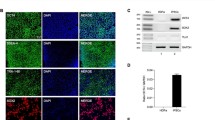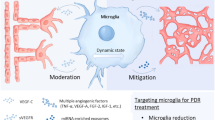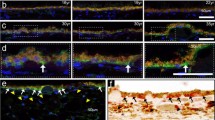Abstract
The underlying mechanisms leading to persistence of human cytomegalovirus (HCMV) in the immune privileged retina are not fully understood. This in vitro study was done to evaluate the influence of HCMV-infected retinal glial cells on epithelial barrier functions. Glial cells derived from human eyes were cultured and infected with the clinical HCMV isolate Hi91. Supernatants of mock (GSmock) and Hi91 (GSHi91) -infected glial cells were collected at 72 h post inoculation and used for incubation of CaCo-2 cells grown in transwell chambers. Transepithelial electrical resistance (TER) was analyzed as a measure of epithelial integrity. Virus-free GSHi91 but not GSmock increased TER from 250 Ω/cm2 to more than 1,000 Ω/cm2 within 2 h. Increased TER values were measured up to 48 h (n=3). No changes in TER were observed when conditioned supernatants from HCMV-infected human foreskin fibroblasts were used. No evidence of GSHi91-induced modification of β-catenin (zonula adherens) or occludin and ZO-1 (zonula occludens) was found. Our results suggest that HCMV-infected glial cells may support epithelial barrier functions by a yet unknown mechanism. Our findings may help to explain the ocular persistence of HCMV and the maintenance of ocular immune privilege early in infection.



Similar content being viewed by others
References
Egbert PR, Pollard RB, Gallagher JG, Merigan TC (1980) Cytomegalovirus retinitis in immunosuppressed hosts. II. Ocular manifestations. Ann Intern Med 93:664–670
Pepose JS, Holland GN, Nestor MS, Cochran AJ, Foos RY (1985) Acquired immune deficiency syndrome. Pathogenic mechanisms of ocular disease. Ophthalmology 92:472–484
Scholz M, Doerr HW, Cinatl J (2003) Human cytomegalovirus retinitis: pathogenicity, immune evasion and persistence. Trends Microbiol 11:171–178
Rao NA, Zhang J, Ishimoto S (1998) Role of retinal vascular endothelial cells in development of CMV retinitis. Trans Am Ophthalmol Soc 96:111–123
Pecorella I, Ciardi A, Garner A, McCartney AC, Lucas S (2000) Postmortem histological survey of the ocular lesions in a British population of AIDS patients. Br J Ophtalmol 84:1275–1281
Palestine AG, Rodrigues MM, Macher AM, Chan CC, Lane HC, Fauci AS, Masur H, Longo D, Reichert CM, Steis R (1984) Ophthalmic involvement in acquired immunodeficiency syndrome. Ophthalmology 91:1092–1099
Scholz M, Hamann A, Blaheta RA, Auth MK, Encke A, Markus BH (1992) Cytomegalovirus- and interferon-related effects on human endothelial cells. Cytomegalovirus infection reduces upregulation of HLA class II antigen expression after treatment with interferon-gamma. Hum Immunol 35:230–238
Cinatl J Jr, Blaheta R, Bittoova M, Scholz M, Margraf S, Vogel JU, Cinatl J, Doerr HW (2000) Decreased neutrophil adhesion to human cytomegalovirus-infected retinal pigment epithelial cells is mediated by virus-induced up-regulation of Fas ligand independent of neutrophil apoptosis. J Immunol 165:4405–4413
Cinatl J Jr, Margraf S, Vogel JU, Scholz M, Cinatl J, Doerr HW (2001) Human cytomegalovirus circumvents NF-κB dependence in retinal pigment epithelial cells. J Immunol 167:1900–1908
Abbott NJ (2002) Astrocyte-endothelial interactions and blood-brain barrier permeability. J Anat 200:629–368
Zolotarevsky Y, Hecht G, Koutsouris A, Gonzalez DE, Quan C, Tom J, Mrsny RJ, Turner JR (2002) A membrane-permeant peptide that inhibits MLC kinase restores barrier function in in vitro models of intestinal disease. Gastroenterology 123:163–172
Cinatl J Jr, Cinatl J, Mainke M, Weissflog A, Steigmann G, Rabenau H, Doerr HW, Kornhuber B (1992) Aphidicolin selectively kills neuroblastoma cells in vitro. Cancer Lett 67:199–206
Cinatl J Jr, Bittoova M, Margraf S, Vogel JU, Cinatl J, Preiser W, Doerr HW (2002) Cytomegalovirus infection decreases expression of thrombospondin-1 and -2 in cultured human retinal glial cells: effects of antiviral agents. J Infect Dis 182:643–651
Sheibani N, Sorenson CM, Cornelius LA, Frazier WA (2000) Thrombospondin-1, a natural inhibitor of angiogenesis, is present in vitreous and aqueous humor and is modulated by hyperglycemia. Biochem Biophys Res Commun 267:257–261
Brocco MA, Panzetta P (1999) Survival and process regrowth of purified chick retinal ganglion cells cultured in a growth factor lacking medium at low density. Modulation by extracellular matrix proteins. Brain Res Dev Brain Res118:23–32
Vestweber D (2002) Regulation of endothelial cell contacts during leukocyte extravasation. Curr Opin Cell Biol 14:587–593
Braga VM (2002) Cell-cell adhesion and signalling. Curr Opin Cell Biol 14:546–556
Tinsley JH, Ustinova EE, Xu W, Yuan SY (2002) Src-dependent, neutrophil-mediated vascular hyperpermeability and beta-catenin modification. Am J Physiol Cell Physiol 283:C1745–1751
Acknowledgements
We thank Lena Kleinbub for the highly appreciated technical assistance.
Author information
Authors and Affiliations
Corresponding author
Rights and permissions
About this article
Cite this article
Scholz, M., Margraf, S., Menon, S. et al. Supernatants from human cytomegalovirus (HCMV)-infected retinal glial cells increase transepithelial electrical resistance in a cell culture model: evidence of HCMV immune escape in the eye?. Med Microbiol Immunol 193, 205–208 (2004). https://doi.org/10.1007/s00430-003-0187-9
Received:
Published:
Issue Date:
DOI: https://doi.org/10.1007/s00430-003-0187-9




